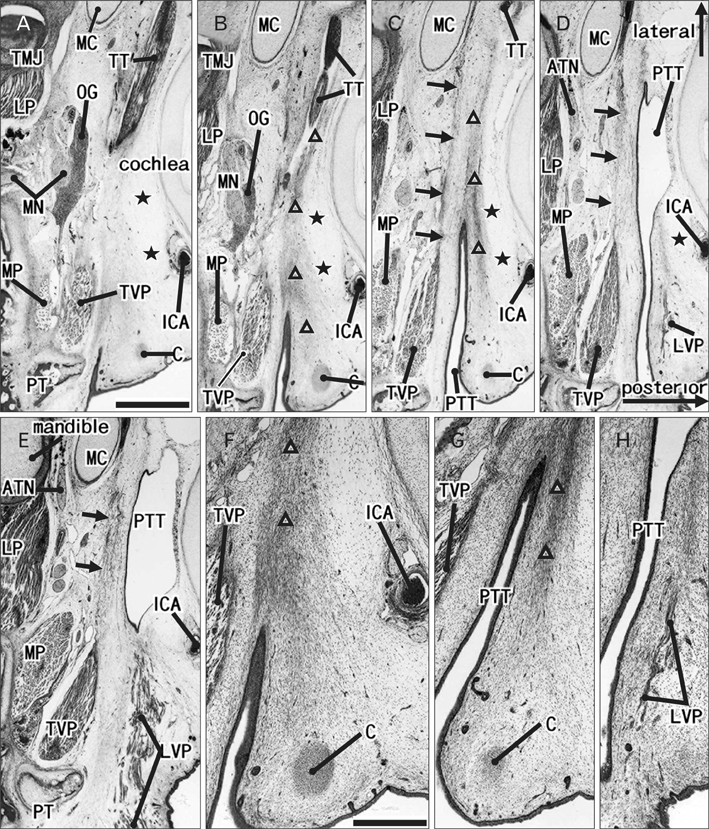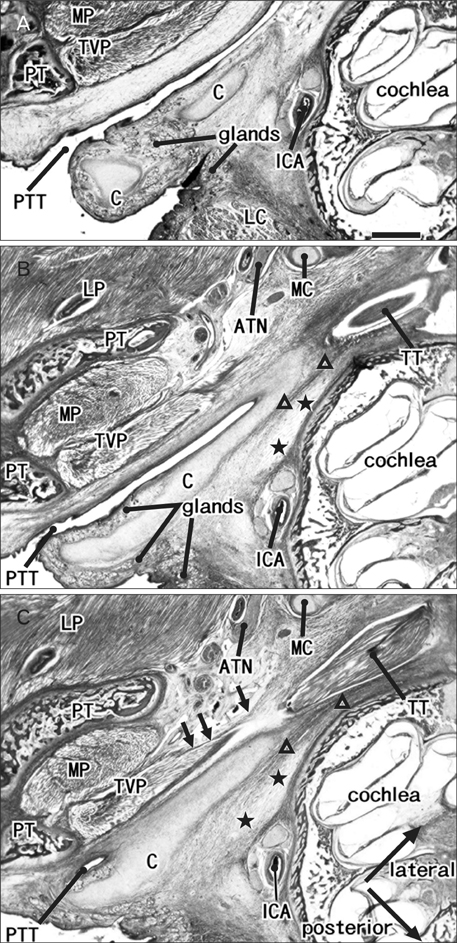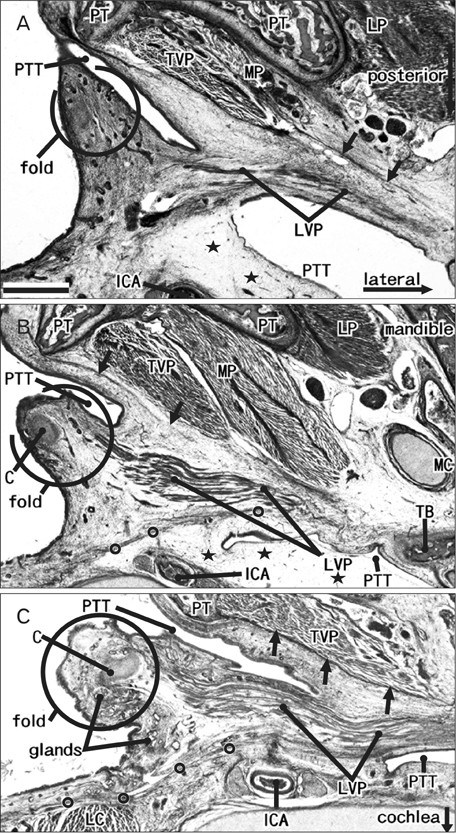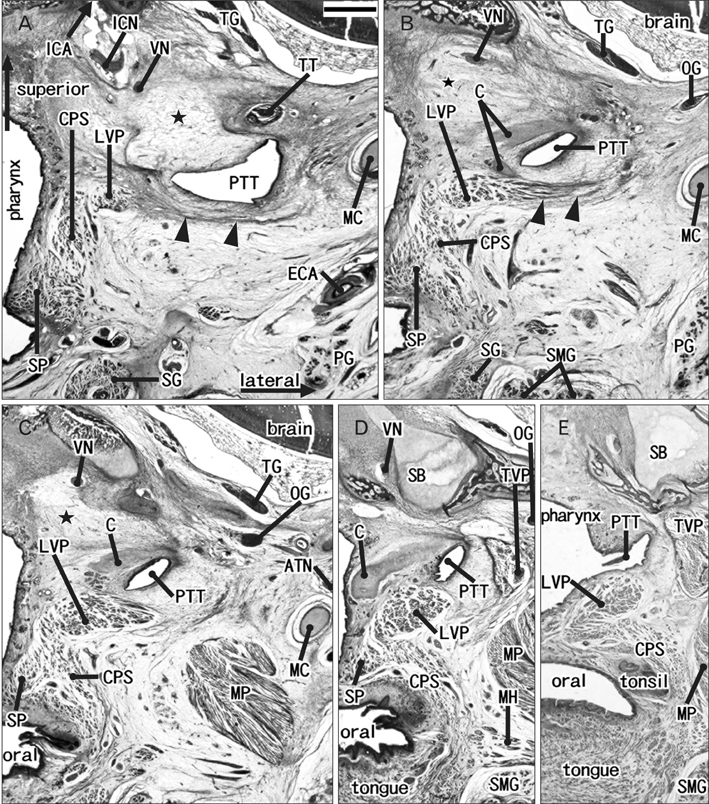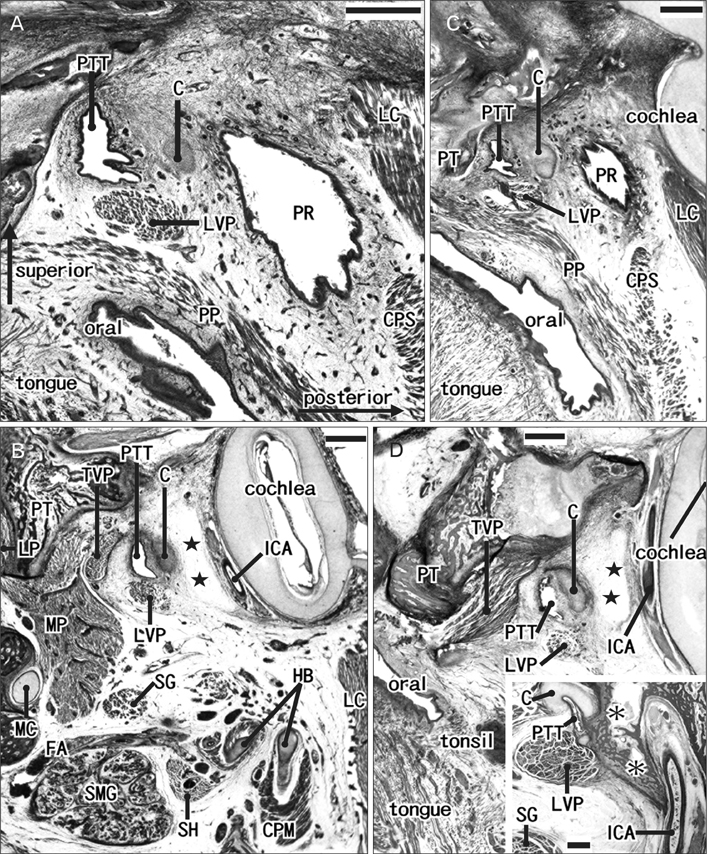Anat Cell Biol.
2012 Sep;45(3):185-192. 10.5115/acb.2012.45.3.185.
Initial stage of fetal development of the pharyngotympanic tube cartilage with special reference to muscle attachments to the tube
- Affiliations
-
- 1Division of Otorhinolaryngology, Sendai Municipal Hospital, Sendai, Japan. entsendai@yahoo.co.jp
- 2Department of Anatomy and Embryology II, Faculty of Medicine, Complutense University, Madrid, Spain.
- 3Division of Internal Medicine, Iwamizawa Kojin-kai Hospital, Iwamizawa, Japan.
- 4Laboratory of Rehabilitative Auditory Science, Tohoku University Graduate School of Biomedical Engineering, Sendai, Japan.
- 5Department of Otolaryngology-Head and Neck Surgery, Tohoku University Graduate School of Medicine, Sendai, Japan.
- KMID: 2046746
- DOI: http://doi.org/10.5115/acb.2012.45.3.185
Abstract
- Fetal development of the cartilage of the pharyngotympanic tube (PTT) is characterized by its late start. We examined semiserial histological sections of 20 human fetuses at 14-18 weeks of gestation. As controls, we also observed sections of 5 large fetuses at around 30 weeks. At and around 14 weeks, the tubal cartilage first appeared in the posterior side of the pharyngeal opening of the PTT. The levator veli palatini muscle used a mucosal fold containing the initial cartilage for its downward path to the palate. Moreover, the cartilage is a limited hard attachment for the muscle. Therefore, the PTT and its cartilage seemed to play a critical role in early development of levator veli muscle. In contrast, the cartilage developed so that it extended laterally, along a fascia-like structure that connected with the tensor tympani muscle. This muscle appeared to exert mechanical stress on the initial cartilage. The internal carotid artery was exposed to a loose tissue facing the tubal cartilage. In large fetuses, this loose tissue was occupied by an inferior extension of the temporal bone to cover the artery. This later-developing anterior wall of the carotid canal provided the final bony origin of the levator veli palatini muscle. The tubal cartilage seemed to determine the anterior and inferior margins of the canal. Consequently, the tubal cartilage development seemed to be accelerated by a surrounding muscle, and conversely, the cartilage was likely to determine the other muscular and bony structures.
Keyword
MeSH Terms
Figure
Cited by 1 articles
-
Fetal development of the carotid canal with special reference to a contribution of the sphenoid bone and pharyngotympanic tube
Yohei Honkura, Masahito Yamamoto, José Francisco Rodríguez-Vázquez, Gen Murakam, Hiroshi Abe, Shin-ichi Abe, Yukio Katori
Anat Cell Biol. 2021;54(2):259-269. doi: 10.5115/acb.20.310.
Reference
-
1. Katori Y, Rodríguez-Vázquez JF, Kawase T, Murakami G, Cho BH, Abe S. Early fetal development of hard tissue pulleys for the human superior oblique and tensor veli palatini muscles. Ann Anat. 2011. 193:127–133.2. Katori Y, Takeuchi H, Rodríguez-Vázquez JF, Kitano H, Murakami G, Kawase T. Fetal development of the human epiglottis revisited: appearance of GFAP-positive mesenchymal cells and fibrous connections with other laryngeal and lingual structures. Ann Anat. 2011. 193:149–155.3. Swarts JD, Rood SR, Doyle WJ. Fetal development of the auditory tube and paratubal musculature. Cleft Palate J. 1986. 23:289–311.4. Couly G, Grapin-Botton A, Coltey P, Ruhin B, Le Douarin NM. Determination of the identity of the derivatives of the cephalic neural crest: incompatibility between Hox gene expression and lower jaw development. Development. 1998. 125:3445–3459.5. Ruhin B, Creuzet S, Vincent C, Benouaiche L, Le Douarin NM, Couly G. Patterning of the hyoid cartilage depends upon signals arising from the ventral foregut endoderm. Dev Dyn. 2003. 228:239–246.6. Santagati F, Minoux M, Ren SY, Rijli FM. Temporal requirement of Hoxa2 in cranial neural crest skeletal morphogenesis. Development. 2005. 132:4927–4936.7. Minoux M, Antonarakis GS, Kmita M, Duboule D, Rijli FM. Rostral and caudal pharyngeal arches share a common neural crest ground pattern. Development. 2009. 136:637–645.8. Rodríguez-Vázquez JF, Murakami G, Verdugo-López S, Abe S, Fujimiya M. Closure of the middle ear with special reference to the development of the tegmen tympani of the temporal bone. J Anat. 2011. 218:690–698.9. Plank J, Rychlo A. A method for quick decalcification. Zentralbl Allg Pathol. 1952. 89:252–254.10. Khoo FY, Kanagasuntheram R, Chia KB. Variations of the lateral recesses of the nasopharynx. Arch Otolaryngol. 1967. 86:456–462.11. Hayes MA. Abdominopelvic fasciae. Am J Anat. 1950. 87:119–161.12. Matsubara A, Murakami G, Niikura H, Kinugasa Y, Fujimiya M, Usui T. Development of the human retroperitoneal fasciae. Cells Tissues Organs. 2009. 190:286–296.13. Miyake N, Hayashi S, Kawase T, Cho BH, Murakami G, Fujimiya M, Kitano H. Fetal anatomy of the human carotid sheath and structures in and around it. Anat Rec (Hoboken). 2010. 293:438–445.14. Abe M, Murakami G, Noguchi M, Kitamura S, Shimada K, Kohama GI. Variations in the tensor veli palatini muscle with special reference to its origin and insertion. Cleft Palate Craniofac J. 2004. 41:474–484.15. Rohan RF, Turner L. The levator palati muscle. J Anat. 1956. 90:153–154.16. Klueber K, Langdon HL. Anatomy of musculus levator veli palatini in the 15-week human fetus. Acta Anat (Basel). 1979. 105:94–105.17. Doyle WJ, Kitajiri M, Sando I. The anatomy of the auditory tube and paratubal musculature in a one month old cleft palate infant. Cleft Palate J. 1983. 20:218–226.18. Takasaki K, Sando I, Balaban CD, Ishijima K. Postnatal development of eustachian tube cartilage. A study of normal and cleft palate cases. Int J Pediatr Otorhinolaryngol. 2000. 52:31–36.19. Mallo M, Schrewe H, Martin JF, Olson EN, Ohnemus S. Assembling a functional tympanic membrane: signals from the external acoustic meatus coordinate development of the malleal manubrium. Development. 2000. 127:4127–4136.
- Full Text Links
- Actions
-
Cited
- CITED
-
- Close
- Share
- Similar articles
-
- Immunohistochemical Localization of Insulin-Like Growth Factor-I in the Eustachian Tube of the Rat
- Unilateral Vocal Cord Palsy after Endotracheal Intubation: A case report
- Fetal development of the carotid canal with special reference to a contribution of the sphenoid bone and pharyngotympanic tube
- Comment on: Trans-Tympanic Cartilage Chip Insertion for Intractable Patulous Eustachian Tube
- The Morphologic Study of Elastic Structures in the Developing Murine Eustachian Tube

